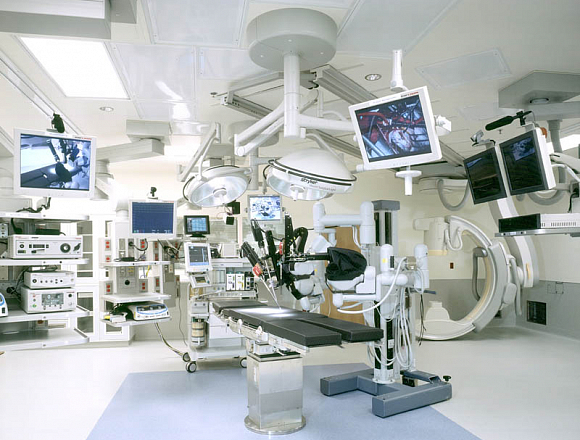Angiography. Access and Diagnosis

Angiography is a method of endovascular examination of vessels with the contrast agent advancing to obtain an image of the vasculature, which allows to evaluate its functional state. With help of angiography, physician can identify the place of narrowing or blockage of the vessel, the place and degree of pathological vasodilation (aneurysm), the presence of internal bleeding, the degree of tumor spread process and other diseases that cannot be detected.
Mainly angiography is used to determine diseases, which are based on vascular injures - atherosclerosis (CHD, obliterating atherosclerosis of the lower extremities, cerebral artery sclerosis, hypertension of different etiology, blockage of the pulmonary artery, etc.).
Depending on the treatment purpose physician performs either general (contrast media introduction into the main vessels and heart cavities) or selective angiography (contrast media injecting directly into the target vessel of small caliber vessel).
Depending on the indications and existing pathology angiography can be both a purely diagnostic and a stage of therapeutic manipulations. It means that during angiography procedure it is possible to pass to direct endovascular treatment of the found pathology.
The main set of endovascular surgical instruments for angiography:
-
Introducer kit
-
Angiographic Catheter
-
Guide Wire
There is a number of accessories which are used for endovascular interventions: artery compression devices, torque devices, hemostatic valves, inflators, a syringes for contrast media injection, manifolds, 2-and 3-way stopcock, Y-connectors, angiographic needles, obturators, vascular dilators, etc.
Daksmed Group of Companies portfolio there is a full range of products for the angiographic procedures provided by various manufacturers including: Terumo.
Actual positions
Radifocus® Glidecath® is a hydrophilic angiographic catheter intended to catheterize peripheral and neurovasculature for use in angiographic procedures in peripheral and neurovasculature.
It delivers radiopaque media and therapeutic agents to selected sites in the vascular system.
It is also used to lead a guide wire or a catheter into the target site.
Glidecath® shares the same hydrophilic coating as Terumo Guide wire M that allows to reach the more distal point in the most tortuous anatomy.
Glidecath® is also indicated to deliver embolic material such as Beads, PVA particles and Macro coils.
Product Features:
• Distal hydrophilic coating at 15 – 25 – 40 cm depending on catheter type and length providing an excellent navigability and allows to selectively catheterize the most tortuous anatomy.
• Superior braiding structure: single braiding for 5 Fr and double braiding for 4 Fr providing an excellent trackability especially when used in combination with Terumo Hydrophilic guide wires.
• Smooth radiopaque surface to prevent thrombus formation and to ensure high visibility under fluoroscopy.
• A larger lumen for a lower profile, Glidecath® 4 Fr (1.40 mm) with 0.038” (0.97mm) guide wires and can be used as a guiding catheter for Microcatheter such as Terumo Progreat.
• Resistant to high pressure: 750 psi (5.171 kPa) for 4 Fr and 1000 psi (6.895 kPa) for 5 Fr.
• Special curve and length available such as 150 cm straight for lower limb recanalisation and Yashiro 3D shape for celiac trunk easier access.
Transradial access is a method that allows to perform all the necessary interventional procedures, using not the femoral, but the radial artery of the forearm. In many cases such access is safer for the patient and does not require long-term bed rest period. That’s why radial access occupies a dominant position and is used in most interventions.
Transradial injury is smaller than femoral so it allows the doctor to reach hemostasis quickly. Indications for radial access are: good pulsation of the radial artery with adequate collateral circulation from the ulnar artery through the palmar arterial arc.
Introducers are intended to be inserted percutaneously into a vessel to facilitate the entire interventional procedure.
Being a pioneer and a leader in vascular access, Terumo’s goal is to offer complete solution for transradial interventions with devices that minimize patient stress and optimize transradial procedure.
With technology including superior coating and downsizing, Terumo continues to set new standards in transradial interventions.
Product Features:
• Dilator is tapered to each guide wire to minimize vessel trauma
• Introducer Kit with hydrophilic M Coating offers smoother insertion and removal for routine transradial procedures
• Unique Terumo cross-cut valve maintains uncompromised haemostasis to avoid bleeding and air aspiration
• Smooth sheath-to-dilator transition and optimally tapered dilator enable to reduce penetration resistance
• Extremely thin radiopaque wall with anti-kinking sleeve for excellent catheter handling
• Snap-on dilator to prevent dilator back-out during insertion and to allow one hand unlocking
